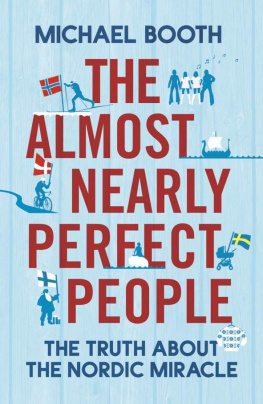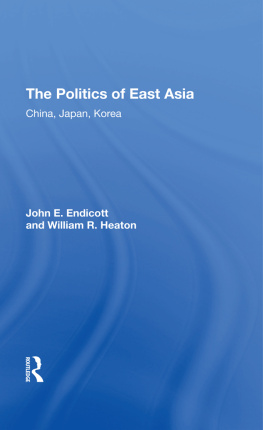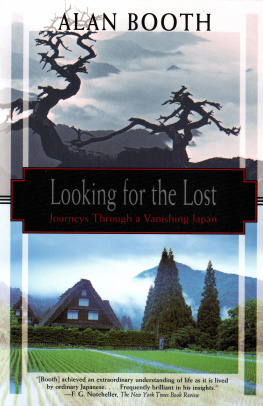The author and publisher have provided this e-book to you for your personal use only. You may not make this e-book publicly available in any way. Copyright infringement is against the law. If you believe the copy of this e-book you are reading infringes on the authors copyright, please notify the publisher at: us.macmillanusa.com/piracy.
T he two tiny dots of blue icing, each barely a millimeter in diameterthey were the problem. They were a component of a dessert, a rather appetizing-looking mango mousse entitled Spring of the People, which, it had been announced, was to be served at a dinner in honor of the leaders of South and North Korea. The dots were virtually invisible, but the Japanese saw them, and they were not happy.
It is extremely regrettable and not acceptable, said a Japanese foreign ministry spokesperson when news of the dots leaked ahead of the historic meeting in April 2018. We have asked that the dessert not be served.
The Japanese made a formal complaint and lobbied hard for the mousse to be struck from the menu, to no avail. Indeed, on the day of the dinner, Moon Jae-in, president of the Republic of Korea, and Kim Jong-un, leader of the Democratic Peoples Republic of Korea, applauded with special enthusiasm as their pudding was served.
The reason for the Japanese indignation was that the dots were part of a chocolate map of the Korean Peninsula. They represented a group of disputed islands, really not much more than a few lumps of rock, located 177 miles off the east coast of South Korea. In Korea the rocks are known as the Dokdo Islands, in Japan as Takeshima, and in the English-speaking world as the Liancourt Rocks. Ownership of the islands is hotly disputed by Japan and South Korea. Koreas claim goes back to the twelfth-century Samguk Sagi, the chronicles of their Three Kingdoms era. The Japanese say the islands have been used by their fishermen for hundreds of years and point out that South Koreas claim was turned down by the Americans at the 1951 San Francisco Peace Conference.
Though the leaders of the two Koreas were technically at war at the time of the official dinner, and though one of them was a despot threatening the security of East Asia and responsible for the deaths of thousands of his own people, on one topic they could agree wholeheartedly.
The Japanese could go whistle.
To the Koreans, North and South, those two dots of icing represented defiance of the former oppressor; to the Japanese, they were a needless provocation; to the Chinese, doubtless monitoring events closely, they were a heartening sign of the ongoing hostility between their two neighbors, as a strong Japan-Korea alliance would be highly threatening to Beijing.
I watched all this unfold on the TV news in my hotel room in Taipei, Taiwan, at the very end of my journey around this troubled neighborhood. With all I had seen and learned of the regions history by that stage, I had a fair idea of what the dessert meant. In those two little dots of icing, one could also see tens of millions of innocent people dead; the destruction of cities and the fall of empires; oppression, occupation, and exploitation, and above all, a festering animosity, which, at any moment, could develop into a devastating regional war with consequences for the world.
So why cant the nations of East Asia get along? How deep, really, is the enmity among Japan, Korea, and China, and what keeps it alive today? Whose interests are served by sabotaging the peace among these three Asian tigers? These are some of the questions that had prompted my journey through a part of the world that has fascinated me throughout my adult life.
Rhetoric is ramped up by political leaders and diplomats seemingly at will, their constituents react accordingly, and the rest of the world sighs at the predictable futility of it all. And the tension is growing. China is rapidly amassing the worlds largest military, and its navy dominates the regions oceans; Japans political rulers are attempting to overturn its pacifist constitution to permit a more aggressive military capability; and a unilateral declaration of independence from Taiwan would almost certainly prompt China to invade, with the potential to draw in America, which has tens of thousands of military personnel stationed in the region. And then of course there is the Little Rocket Man in Pyongyang, with his fat finger still supposedly poised over a nuclear button. And the bad blood in East Asia is not limited to its governments and military leaders. Hatredproper, visceral, blind hatredsimmers among the people of these countries, every once in a while erupting into violence.
In 2012, in the Chinese city of Xian in Shaanxi Province, a man, Li Jianli, aged fifty-one, was dragged from his car and beaten almost to death by a mob following the Japanese governments nationalization of some other disputed rocks in the sea, in this case the Senkaku Islands, which lie between Taiwan and Okinawa. Li wasnt even Japanese; he just happened to be driving a Japanese car. The then Japanese ambassador to China, Uichiro Niwa, meanwhile, was fortunate to escape when his car was attacked in the streets of Beijing the same week.
Some of the popular protests are weekly affairs. During my journey I spent some time at a demonstration by a couple of hundred protesters outside the Japanese embassy against the sexual enslavement of women by the Japanese military during World War II; the demonstration has taken place every single Wednesday since 1992. A large part of the crowd comprised schoolchildren. One expects florid anti-Japanese rhetoric from the North Korean regime, but why is the anger concerning events that took place over seventy years ago still so vibrant among young South Koreans? And the hatred of Japanese by Koreans is reciprocated, at least by a minority, in Japan. Earlier on in my trip, in Yokohama, I had witnessed a convoy of black minivans pass me by, a tirade of anti-Korean invective spewing from their loudspeakers. This wasnt the first time I had seen such things in Japan. For many years various right-wing factions have been taking to the streets of Japanese cities to threaten and insult the ethnic communities, particularly in Osaka, home to the countrys largest Korean population. But what could the Japanese possibly have against the Koreans? Were these merely tit-for-tat demonstrations, or was the hatred as deep on both sides of the Sea of Japan?
The disputes do not always involve Japan versus its neighbors; they are multidirectional. The installation in 2017 of an American missile defense system on a golf course south of Seoul had greatly antagonized Beijing, resulting in an immediate and precipitous drop in tourists traveling from China, enough to shake the South Korean economy. Although the missiles were ostensibly intended to counter the threat from North Korea, the Chinese felt menaced by the presence of yet more American military technology so close to their borders, and they made their neighbors pay with unofficial trade sanctions.
These hostilities of course have their roots in the regions history, a litany of man-made hellishness featuring war, massacre, mass rape, biological weapons, firebombing, totalitarianism, famine, destitution, political oppression, torture, and atomic destruction, all of which remain vivid in the collective consciousness.









